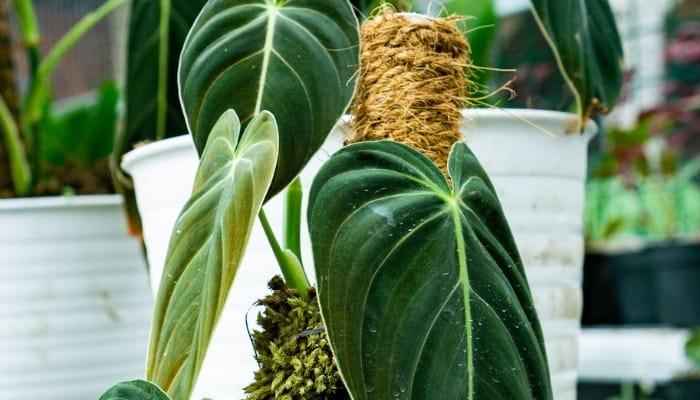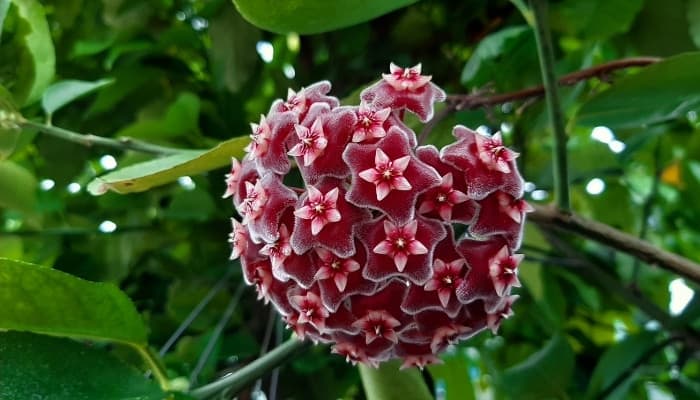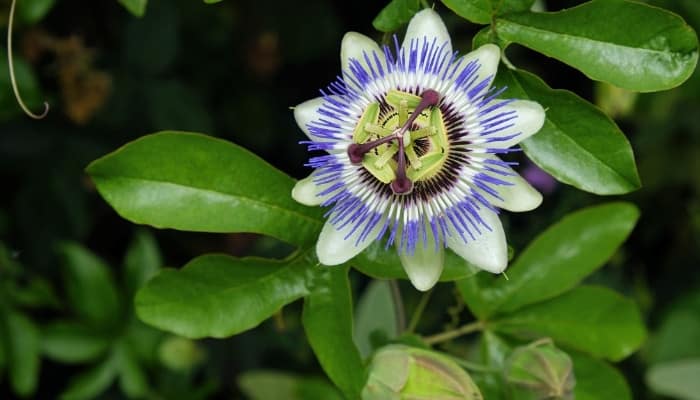Moss poles are a valuable tool for numerous indoor gardeners, but they may not be suitable for all plants.
Some houseplants, specifically epiphytes and climbing vines, require a vertical support structure to grow to their full potential.
Moss poles are superior to simple stakes or trellises because the moss holds moisture and gives aerial roots a place to secure themselves.
Here is a list of the best plants to grow on a moss pole.
1. Philodendron

Philodendrons come in a variety of shapes, sizes, and colors. Some philodendrons are self-supporting, but the climbing varieties will benefit from the use of a moss pole.
The climbing varieties are epiphytes that grow on the trunks of trees in the wild. They use aerial roots to obtain moisture and nutrients from the moss pole.
Popular Climbing Varieties
- Heartleaf philodendron
- Philodendron ‘Brasil’
- Philodendron ‘Micans’
- Philodendron brandtianum
2. Monstera

Like climbing philodendrons, monsteras are epiphytes native to the rainforest. They showcase their large leaves with unique fenestrations.
Monsteras are a group of plants that should be grown on a moss pole. They thrive when allowed to grow in their natural manner.
Many monstera owners report more beautiful and larger foliage when using a moss pole.
Popular Climbing Varieties
- Monstera deliciosa
- Monstera adansonii
- Monstera dubia
3. Pothos

For many house plant enthusiasts, pothos plants are their first introduction to the domain. These plants are easy to care for and grow quickly during the warm months.
Pothos is often grown as a trailing plant with the long vines allowed to fall over the side of the pot. Thanks to its aerial roots, pothos plants can also be trained to climb a moss pole.
Popular Climbing Varieties
- Satin pothos
- Neon pothos
- Silver pothos
- Pearls and jade pothos
- Marble queen pothos
4. Hoya

Hoya is a diverse group of plants that climb and grow vines. Some people like to grow their hoyas on metal trellises and uniquely shaped structures.
A simple moss pole is a beautiful and neutral way to show off your hoya plants. The aerial roots will be able to grip the moss pole and absorb moisture for the plant.
Popular Climbing Varieties
- Hoya pubicalyx
- Hoya kentiana
- Hoya australis
5. Ivy

Commonly pictured growing on old brick houses and walls, ivy can also be taught to climb indoors.
By using a moss pole, you can allow this naturally occurring vining plant to grow vertically within your home. All varieties of ivy are climbers, so you can train whichever one is your favorite.
Popular Climbing Varieties
- English ivy
- Algerian ivy
- Boston ivy
6. Creeping Fig

Creeping fig is a climber that is similar to ivy. It will easily grow on walls and the outside of buildings.
With the proper climate, this plant can also be successfully grown indoors on a moss pole.
Without a climbing structure like a moss pole, vines will get scraggly and desperately grow in all directions, looking for something to hold onto.
7. Jasmine

Jasmine is easily recognized for the intoxicating scent that the flowers give off. This is another plant that is commonly trained to climb outside.
With enough light, your indoor jasmine will still grow up your moss pole, and you may even be rewarded with some beautiful flowers.
Jasmine is a vining plant that still gets a vast majority of its nutrient and moisture needs from the soil it is rooted in. All varieties of jasmine will climb a moss pole.
8. Arrowhead Vine

Arrowhead plants are interesting members of this list because they are not true vines or epiphytes.
Most of the arrowhead plant is centered around its root system, but it will send out vining stems periodically. These vines help the plant to grow and expand.
A moss pole would allow your arrowhead plant to grow an interesting shape. The main part of the plant will be bushier and full of foliage, and leggier stems will head up the moss pole.
Popular Climbing Varieties
- ‘Strawberry Cream’
- ‘Berry Allusion’
- ‘Painted Arrow’
9. Trailing Begonia

Begonias are commonly used in hanging baskets because they fill out the container nicely.
Trailing begonias will either spread out across an area or they can be trained to climb a porous structure. Unlike vines, trailing begonias need to put down roots.
This makes the moss pole a perfect structure. The moss provides moisture and nutrients for the growing plant.
Popular Climbing Varieties
- Begonia boweri
- Begonia imperialis
- Begonia rex
10. Wandering Jew

Wandering Jew is the common name for a collection of plants that exhibit beautiful foliage. The most popular variety, Tradescantia zebrina, is loved for its deep purple, light pink, and green coloration.
This plant produces aerial roots that allow it to climb a moss pole and fill up the entire space. With proper care, Wandering Jews will grow quickly and you will have full foliage in no time.
Popular Climbing Varieties
- Tradescantia zebrina
- Tradescantia fluminensis
11. Pilea

Pileas are not true climbers. They do not produce vines or aerial roots. However, some varieties will grow better when offered a support structure.
For example, the Chinese money plant can grow lots of round leaves, but the thin trunk often falls over from the weight. By using a thin moss pole as a support, the plant can grow bushier.
Popular Climbing Varieties
- Chinese money plant
- Gray baby tears
12. Maidenhair Vine

Maidenhair vine is known for its thin stems and small leaves. The stems can grow to be many feet in length.
This plant is often used as ground cover because it does an excellent job of spreading out and taking over a space.
When grown on a moss pole, the plant will quickly overcome the pole and leave you with a beautiful vertical plant covered in small, attractive leaves.
Popular Climbing Varieties
- Muehlenbeckia axillaris
- Muehlenbeckia complexa
- Muehlenbeckia platyclados
13. Passion Flower

Passion flowers are the plants that produce passion fruits. Only some varieties are used for food cultivation, but all passion flower plants will produce fruits in the right conditions.
The exotic and gorgeous flowers produced by the passion vines are the main appeal of this plant.
When planted outside, passion vines will overcome nearby plants or fill out a trellis. Indoors, a moss pole provides a strong structure for your passion flower to thrive on.
Popular Climbing Varieties
- Passiflora caerulea
- Passiflora coccinea
- Passiflora incarnata
14. Black-Eyed Susan Vine

The black-eyed Susan vine (Thunbergia alata) is an excellent climber. It can successfully climb trellises, walls, and moss poles. This plant grows long and grows fast.
The best feature of black-eyed Susan vine is the vibrant yellow or orange flowers that it produces. These flowers will add beautiful energy to any indoor or outside space.
15. Mandevilla

Mandevilla, or rocktrumpet, is another blooming vine. Pink is the most common flower color, but shades of white and red can also be found.
These plants are particularly fast growing in the right conditions. Due to their speedy growth, they are often grown outside.
It is possible to grow them successfully indoors, but you’ll need to make sure they are getting enough sunlight.
Popular Climbing Varieties
- Mandevilla sanderi
- Mandevilla boliviensis
- Mandevilla laxa
16. Bougainvillea

Bougainvillea are known for two things: intense thorns and crepe-like flowers. The flower petals have a unique and almost see-through texture.
The thorns of bougainvillea can make them hard to prune and manage. However, growing your bougainvillea on a moss pole can keep it to a manageable size with regular trimming.
Popular Climbing Varieties
- Bougainvillea glabra
- Bougainvillea spectabilis
How To Make a Moss Pole
It is very easy to make a moss pole at home. All you need is a central support structure (PVC, a wooden towel, or a plastic stake will work), sphagnum moss, and string.
First, soak the sphagnum moss in water for 15-20 minutes. Once the moss has been hydrated, squeeze out any excess water.
Then, use the string to secure the moss to the central pole. It is best to do this in layers with multiple pieces of string. Leave the bottom 6-12 inches free since this portion will be under the soil.
How To Train a Plant To Climb a Moss Pole
It is best to begin training a plant to climb a moss pole while it is small and young. Once the stems are long enough, use fishing line or string to gently secure the stems to the moss pole.
If the plant has aerial roots, make sure that they are facing inward toward the wet moss. Aerial roots will eventually secure the plant to the pole, and string will no longer be necessary.
Vining plants will continue to grip the moss pole and climb once they have been trained.
Conclusion
Not all plants will be able to climb a moss pole. It is important to choose a climbing epiphyte or a vining plant that will be able to cling to the moss pole.
These options will thrive with a tall moss pole to climb and grow to their full potential.

![Plants for Moss Poles: 16 Top Picks [And How To Train Them]](https://whyfarmit.com/wp-content/uploads/2022/02/Monstera-on-moss-pole.jpg)